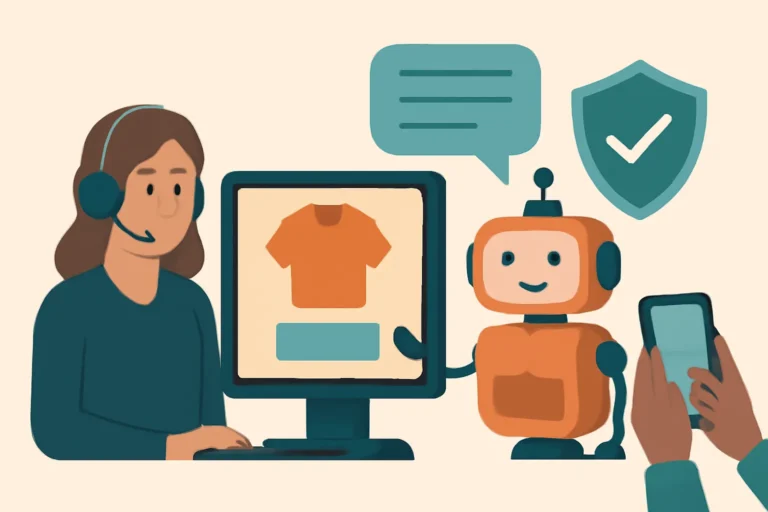Artificial intelligence is no longer a science fiction book and is transforming the way business organizations engage with customers. The high-tech customer emerging requires immediate, customized, and seamless interaction that the traditional customer service model cannot offer. From chatbots to advanced systems that can anticipate needs, personalize interaction, and automate end-to-end support processes, AI-powered customer service integration has come of age. As a means of being able to continue conducting business and address increasing demands from youthful consumers, business leaders have to efficiently run their businesses amidst this new reality. Apart from taking advantage of AI, the most innovative companies are developing a whole new supporting system where human beings and AI coexist in harmony. Through this book, you navigate developing an evolutionary customer care process with AI to construct an out-of-the-box customer experience.
Start with a clear plan
Even before you commit to what AI tools to purchase, you need to define your goals. AI is an easy fix, but it is not a magic wand. If you don’t have something in your mind that you want to put it into, you will be using technology that won’t address your actual business issues.
- Identify Pain Points: Begin by identifying your customer service pain points. Are your agents swamped with duplicate calls? Are the wait times longer than they need to be? Is your first contact resolution ratio low? Knowing these specific pain points, you can then identify where customer service AI will be most helpful to you.
- Start with Data, Not Guesswork: For example, if your reps are dedicating half their workday to password resets and order tracking, start there. Your plan must be driven by data, not guesswork. Look at your customer support tickets to see what the top questions are and where automation can make the greatest impact.
The Human and AI Partnership
The largest business blunder being committed is using AI as a substitute for their human workers. The leaders of 2025 leverage AI as a phenomenal ally, not a substitute.
- AI as First Line of Defense: AI is very efficient at handling high-volume, repetitive tasks. Think of it as your first line of defense. Your human agents can focus on complex, high-value interactions that require empathy, creative problem-solving, and a human touch while an AI assistant answers a deluge of simple questions immediately and round-the-clock.
- Smooth Handoffs: The customer must be smoothly passed over to a human agent with the entire context of the AI chat in case the issue is very complex or emotionally charged. Enhanced customer experience is gained through human-AI collaboration that is enhanced with synergy.
From Simple Bots to Intelligent Automation
Although most people still think AI customer service is just about chatbots, more has occurred than that. The focus shifted from basic, rule-based chatbots to more sophisticated automation.

- Beyond Basic Response: Intelligent automation does not end with responding to a straight forward question. It can perform end-to-end processes without the need for human intervention. For instance, an AI actor is not only capable of notifying a customer that his order has been delayed but also refunding the customer, re-booking a delivery, or issuing him a voucher for the next purchase.
- Agentic AI: This will entail integration with your back-end system, i.e., your e-commerce site or CRM. Such “agentic” AI significantly reduces resolution times, enabling customers to solve their problems themselves and at their own convenience.
How to Personalize the Customer Experience
Today’s consumer wants personalization. He wants you to remember his past engagements, understand what he likes and dislikes, and anticipate his needs. This level of personalization was only achievable en masse by AI.
- Data-Driven Personalization: Machine learning can compute the whole history of a customer, the customer’s purchase history, browsing activity, and past support requests in fractions of a second. This enables it to produce highly customized suggestions and fixes.
- Predicting Needs: For instance, a consumer purchasing a product may be directed to a solution or given a preemptive accessory recommendation based on a pattern of past purchase activity. High customer satisfaction and brand loyalty are correlated with the consumer feeling appreciated and acknowledged.
Empowering Human Agents
AI is not just window dressing. Its most significant uses are unseen, and they will make your support team more productive and efficient.
- AI Co-pilot: AI can be an effective co-pilot for your agents. While an agent is communicating with a customer on a call or through a chat, AI can propose in real time what to say next, automatically summarize the record of the customer, and fetch related articles from your knowledge base.
- Brief Training Time: This minimizes information search time and allows agents to focus on the human aspect of the interaction. New agents will have their onboarding time substantially minimized by this kind of AI assistance and will be ready to do it like a pro on day one.
Why an Omnichannel Approach is Necessary
Customers don’t stay on a single channel. They may start with a chat window, continue with an email, and end with a call. Your customer service platform must keep pace with them.
- Conversations Connecting: Conversations may be joined together by AI. An omnichannel AI platform puts the context of all past interactions on all channels in the user’s hands.
- Smooth customer experience: This is having a human representative who can view the entire chatbot conversation history, email, and all of the other conversation history without the customer having to repeat the work. That is, a smooth experience and easy use of time, respectful.
Anticipating Customer Issues
Not only can AI respond to problems, but it can prevent them as well. By analyzing large quantities of data, AI can determine the most likely customers to defect and even detect a customer becoming angry in real-time.

- Sentiment Analysis: It employs natural language processing to find out the emotional tone of the
customer’s voice or message. As soon as the sentiment of a customer becomes negative, AI automatically re-routes the case to the human agent in a bid to prevent the bad experience from getting beyond control. - Predictive Analytics: You would utilize this to examine customer data in a bid to establish patterns toward churn, so you can anticipate and contact these customers ahead of time with exclusive deals or assistance before they plan to leave.
Data Privacy and Security
You will be dealing with more client data the more you implement AI into customer service. This implies data protection and security must be accorded maximum care.
- Strong security standards: To protect confidential client data, AI deployments ought to have strong security standards.
- Openness and Conformity: Be transparent to your customers about how their information is stored and used. This means choosing AI solutions that are CCPA and GDPR compliant, and data management practices need to be open and clear. Getting it right from the ground up is most important because it is harder to regain trust once it has been lost than any other part of technical failure.
Keeping Your AI Smart
AI is an easy piece of equipment to use but one of those forget-it-and-set-it-apart gadgets. Your AI is only as smart as what you trained it on. You’re going to be using AI all day.
- Constant Feedback Loop: You need a constant feedback loop in which you have AI interactions, notice where it wasn’t quite to spec, and use it as a method of tightening up its training.
- Ongoing Audits: Ongoing audits of the AI conversation will recognize future customer issues that crop up or where the AI reply is perplexing or unhelpful. Through constant fiddling with new facts and fine-tuning, your AI system will become smarter and more efficient in customer service in the long term.
Identifying the ROI of AI in Customer Service
To show ROI on your investment in AI, you must be tracking the right stuff. It’s not merely cost reduction.

- End-to-End Perspective of Performance: Cost reduction is a no-brainer ROI, but end-to-end perspective includes CSAT rating on AI conversations, first contact resolution rate on AI-solved cases, and escalation rate to human reps.
- Human Team Impact: Measuring the human team impact, both in terms of their performance and job satisfaction, is also crucial. An effective AI strategy should have positive implications on the entire gamut, from the levels of operational performance to employee satisfaction to customer satisfaction.
Future customer support is a refined ballet of human and machine. You can use artificial intelligence for customer support to create a support system that’s faster, wiser, and more personal than before by organizing your workflow in the right way. Not a band-aid fix, but a sustained, long-term advantage that will inspire your staff and awe your customers for years to come.
FAQs
Q: What is customer service AI?
A: Artificial intelligence to make support smoother, more personalized, and more efficient.
Q: How does AI improve customer service?
A: AI improves the service by speeding up response, tailoring experience, and handling repetitive tasks to improve efficiency and satisfaction.
Q: What does the future hold for customer service AI?
A: More tailoring, predictive servicing, and intelligent agents that can perform end-to-end workflows autonomously.
Q: Will AI displace human customer service agents?
A: No, AI is a facilitator that enables human agents to have their job done by eliminating drudgery so that they can expend their time and energy in meaningful interactions.


